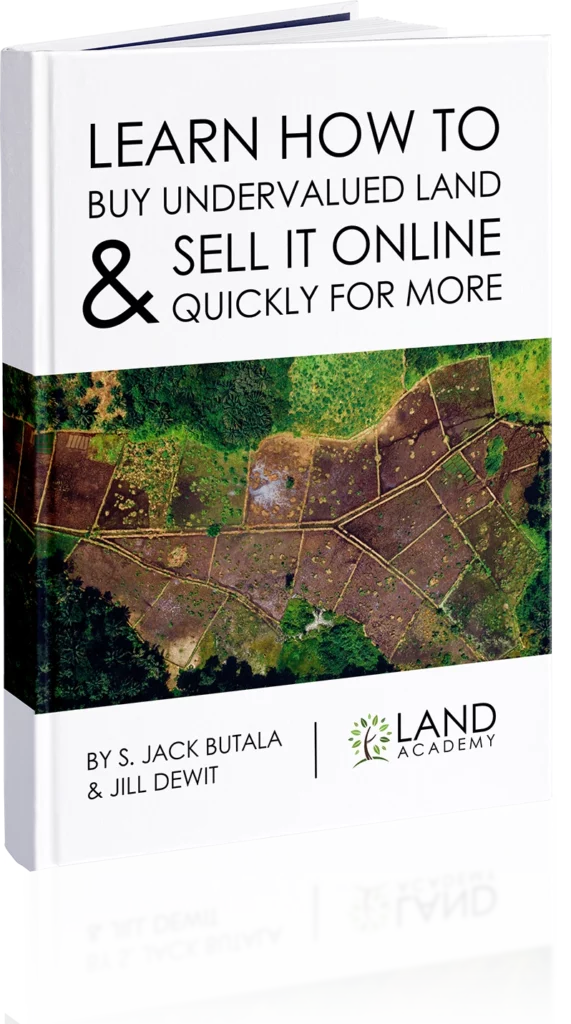Outsourcing due diligence with Infill Reports

By Jason Cochard for Land Academy
So far I’m loving the tactics and learning found in Land Academy 2.0. I’ll let you watch it yourself if you haven’t watched or don’t have access, but buying valuable land comes with higher stakes (there’s more money involved) and thus an expanded set of due diligence steps you’ll want to have the answers for. On my very first mailer, I sent a mailer to some infill lots in an area where a buyer had expressed interest. I got some hate and tons of ignores, probably because my pricing was the pricing of rural vacant land.
However, about a year later, I got an interested seller. He had a hefty counter-offer that made the acquisition more of a risk, but it would still be inexpensive assuming it is buildable. That’s the big question, is it buildable?I checked immediately with my buyer, who is actively looking for land in several states for the perfect place to build her own custom home. She was still interested. Since I know her, I don’t want to be caught in a situation where I sell a parcel to her and find out later that it’s not buildable (I wouldn’t want that even if I didn’t know her, but it’s a heightened with people you do know, right?). And being an end user, she’s not familiar with the amount of due diligence necessary so her answer about buying is always going to be contingent on whether I know whether something is an issue or not. But, she’s willing to pay more than perhaps a savvy investor-builder.
Cue the endless analysis. Not just checking on the title, which we all know how to do pretty quickly, but all the regulations involved with urban land. I started calling the city to check on everything from access to the red tape having to do with appearing before the city council to request a variance on utilities. Calling the utility company to confirm the absence of utilities and the need to extend all four utilities. Learning that extending water and sewer is generally much more expensive than gas & electric. I got to the point where I was spending a ton of time researching the local building code and permitting regulations. This parcel happens to be situated on a hill next to a large celebrated park that is the gem of the city — both an attractive place to build a dream home and potential cause for a ton of community opposition if a city council hearing and public approval became necessary in any way. Because a public hearing could be needed for the variances, I wasn’t sure if the deal was going to work.
Then I got an infill report from infillreports.com, and it was quite simply amazing! All the upfront, unguided time spent on the phone discussing preliminary things with the utilities and planning people was unnecessary. It was already done, explained, and rated for me, ready to follow up on specific issues, complete with the numbers to call. I had spent quite literally hours each day, for days, and I don’t even know how many hours I spent in total just on utilities. Maybe 40 hours spent. Granted, compared with the infill report, I was able to get deeper, more specific information through my calls with the city and utilities companies. But, the infill report with its 1/2/3 rating system for various factors of buildability is able to quickly point you in the right direction to find out what additional work is necessary, if any, guiding you through exactly the issues to follow up on.
With the buildability analysis, a score of 3 means the parcel is buildable as-is; a score of 2 means further action is needed to make it buildable; and a score of 1 is a deal breaker, it’s not buildable in its current condition.
Side note on the Zoning and land use portion of the buildability analysis. I think the included setback analysis is one of the coolest things that comes standard. I always find myself getting a deal back and then having to figure out what the zoning code means, what the setbacks are within that zone, and sometimes confusing myself about which setback is which for my specific parcel. For example, what’s the difference between front setback and side setback for a corner lot? The ambiguity there when looking at small lots can sometimes cause me a headache and become a waste of time, so it’s great to have it all right in front of you right away. The lot I was looking at is 3.44 acres, so setbacks aren’t going to be an issue.
Back to my utilities issue. The infill report was able to show me exactly where the nearest utility connection was. Since it wasn’t at the lot line, I then could begin to call the county/city/utility company and start to zero in on cost and specific ways approach the problem. I had done it in reverse, and although I got the same answers as were in the report, it cost me a lot of time. In the end, the number I called on my own was the same number I would have gotten supplied in the Infill Report. The person on the other end of that line gave me lots of information, lots of insights about the local rules and possible variances to them. Specifically with the municipality I am dealing with, extending water to any given parcel requires a connection to two existing points along the water system. If it were a single point, the flow rate standards would not be met, resulting in bacteria build-up and water quality standards suffering. This is insight I got verbally on the phone, prompted by the infill report’s score of “2” on the Utilities section of the buildability analysis.
Being able to discuss alternatives (regulatory issues surrounding drilling a well in lieu of extending utilities) with the utilities person was fruitful too, but I wouldn’t have known what to ask about without knowing the issues — either intuitively, or from an infill report that tells you exactly where to follow up and which number to call. Intuition can be a dead end when your intuition causes you to chase down a non-issue.And intuition is incomplete. As proud of I was of myself for figuring out the utilities needs, I had no idea that there was an issue with grading, which would need to be addressed before buildability would become a 3. The infill report was able to show me the topography of the site, parcel boundary, and while google maps 3D is also able to show the topography, it’s not always available in all areas. On my parcel, there’s naturally a pretty nice flat part about a half acre large within the 3.44 acres, so grading it as well as the access road to it will need to be done. This gives the lot a 2 for one of the sections. The included Topographic map makes it straightforward for a builder to immediately look at the challenges to grading the access and home-site, and at a glance make a decision on a basis of project complexity.
My lot scored a 3 on all other topics other than utilities and land use. Apart from the very valuable Utilities and Zoning/Land Use buildability characteristics already discussed, the other included buildability characteristics included in the report are:
1. Legal Lot Status, or whether it was properly subdivided. When talking to locals, there’s always seems to be some rumor about something, such as illegal lots, but this allows you to know for sure while continuing to nod and smile about the rumors.
2. Hazard Zones, which is great when a buyer wants to know if it’s in a FEMA flood plain or not.
3. Easements, which is another buzzword every tire kicker seems to ask about. A preliminary title report is included which shows not only easements, but 20 years worth of deeds of trust / mortgages, judgements, UCC-1 filings, and even shows the names used to form the basis of the search. Very valuable!
4. HOA/Deed/Map Restrictions, which will answer everyone’s questions about those issues without you having to do all the research yourself.
After providing the answers for all of these topics, the end of the report provides links to any applicable sections of county/city code, such as permitted uses, zoning and overlay zones, development standards, fire department information, and FEMA.
Overall, I am slightly blown away, and I’ll be finding it hard to do my own due diligence except for low value land. For high value land of any kind, but especially infill lots, I am blown away by the value provided by infillreports.com.

